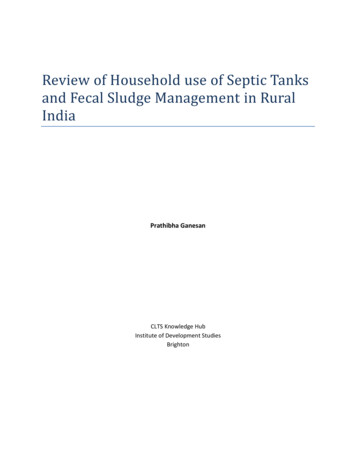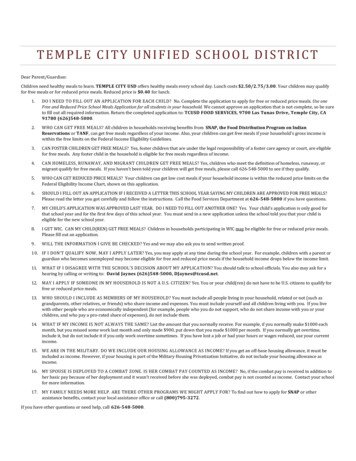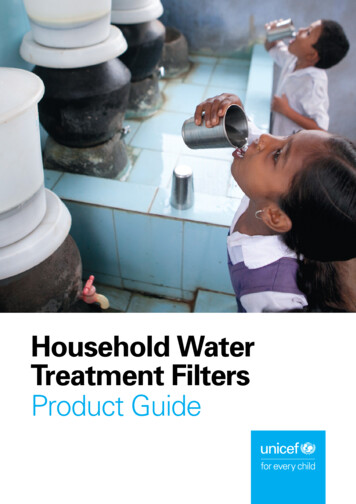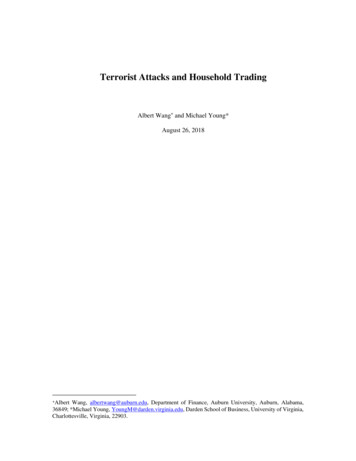
Transcription
Review of Household use of Septic Tanksand Fecal Sludge Management in RuralIndiaPrathibha GanesanCLTS Knowledge HubInstitute of Development StudiesBrighton
ContentsAbstract . 1Introduction . 2Indian Standards for construction of a Septic Tank . 3Methodology . 4People’s choice and experience of Septic Tanks . 6Other observations from the grassroots level . 13Conclusion . 13Policy Suggestions . 14References . 14
AbstractSeptic Tanks (ST) are scientifically designed structures used for primary treatment of liquid waste withsettleable solids. In India, Bureau of Indian Standards provided the specifications for the construction ofan ST. However, ST can produce second generation problems either due to faulty construction orcareless treatment of fecal sludge. A qualitative study was carried out across eight states in the countryto explore the implementation of septic tanks in the rural villages. The study found that while villager’ssocial class, availability of space, and finances influence the adoption of ST, their perception of ST affectits type and design. STs with no soak pit and non-cemented bottom are common which hasenvironmental and health impacts. Effluent pipes connected to drains contaminate fresh water sourcesleading to fecal contamination of water supplies, and disease outbreaks. Similarly, open dumping offecal sludge is regular. Even though, Twin Pits are promoted under SBM-G, in states like Kerala, Punjab,Haryana, etc. ST is widespread. The study, therefore, recommends state intervention in retrofitting theexisting STs, developing a protocol for fecal sludge management and creating awareness among themasons for applying the correct designs.1
IntroductionSeptic Tank is a sanitation technology with a clear design which is promoted in areas where a seweragesystem is absent. It helps in the primary treatment of liquid waste with solid content. Bureau of IndianStandards (BIS) provides standards for construction of septic tanks and the secondary treatment of fecalsludge matter from the septic tanks. However, at the grassroots level construction of septic tanksseldom follow the required standards. Similarly, waste from septic tank needs a secondary treatment,and there is no proper system for emptying the Fecal Sludge Matter which is considerate of theenvironmental impacts in India currently. Unscientific septic tanks and careless disposal of fecal sludgeaffect the environmental and sanitation goals of the country. The BIS document cautions that‘unsatisfactory design, construction, and maintenance of septic tanks constitute a health hazard'Figure 1 Septic tank design, Source: Google images(Bureau of Indian Standards, 1993). Any policy towards sanitation in India should, thus, be considerateabout such issues. Therefore, as part of a larger scheme of knowledge accumulation for Swachh BharatMission- Gramin (SBM-G), this study attempts to investigate the household use of septic tanks and fecalsludge management (FSM) in Indian villages and provide policy suggestions. The report has six mainsections of which the first being the introduction. The second section discusses the design of a septictank and the Indian standards for construction of one. The third section explains the methodology of thestudy. The fourth section provides insights on the actual usage of septic tanks in rural India. The fifthsection discusses the findings, and the sixth section provides the policy suggestions.2
Indian Standards for construction of a Septic TankA septic tank is a rectangular watertight structure used to treat liquid waste with high settleable solids.According to the available literature, a scientifically designed septic tank involves two chambers with aninlet to collect the liquid waste from the pour flush cistern and an outlet to expel the effluent to soakagepit or a sewer. As the black water flows through ST, the solids settle at the bottom of the first chamberand scum moves to the top. The first chamber of the septic tank should be two third of the total lengthof the septic tank. Over time, due to anaerobic digestion, the sludge reduces, and a portion of the solidturns into liquids and gas which rise to the surface in the form of bubbles. At the top of the septic tank, avent is built to expel the gases produced due to anaerobic digestion of the solid waste (Kumar, 2010).Table 1: Parameters of septic tank construction ( Source: BIS,1993)Size of the tank: The Septic tank shall have a minimum width of 750mm and depth of one metre below the outletwith a liquid capacity of 1000 litres. For rectangular septic tanks, the length of the tank shall be 2 to 4 times thewidth. For circular tanks, the minimum diameter shall not be less than 1.35 metre, and operating depth shall notbe less than 1.0 m.Inlet and outlet: For the tanks not more than 1200mm wide, the inlet and outlet are T shaped dip-pipe. The inletpipe shall be fixed inside the tanks with top limb rising above scum level and the bottom limb extending about300 mm below the top water level. Outlet pipe should be fixed inside the tank with top limb rising above scumlevel and the bottom limb extending to about 1/3rd of the liquid depth below top water level.Partitions: Where the capacity of the septic tank exceeds 2000 litres, the tank may be divided into two chambersusing a fixed durable barrier. The partition shall be located so that the capacity of the first chamber is twice that ofthe second chamber.Ventilating pipe: Every septic tank should be provided with a ventilating pipe of at least 50 mm diameter. Thetop of the pipe shall be provided with a suitable cage of mosquito proof mesh.Floor: It is essential that the floor of the tank be watertight and adequate strength to resist earth movement and tosupport the weight of the tank walls and contents. The floor may be of concrete of minimum M15 grade and aminimum slope of 1:10 may be provided towards the sludge outlet to facilitate desludging.Walls: walls should be thick enough to provide adequate strength and water tightness. Walls built of bricksshould not be less than 200 mm thick and should be plastered to a minimum thickness of 12 mm inside andoutside.Desludging: Small domestic tanks for economic reasons may be cleaned at least once in 2 years provided the tankis not overloaded due to use by more than the number for which it is designed. A portion of the sludge not lessthan 25 mm in depth should be left behind in the tank bottom which acts as the seeding material for the freshdeposits.Commissioning the tank: The sewerage system should be complete and ready for operation before connected tothe building. The tank should be filled with water to its outlet level before the first time the tank is used. It shouldpreferably be seeded with small quantities of well-digested sludge obtained from the septic tank or sludgedigestion tanks.Soak pit: Soak pit is a pit through which effluent is allowed to seep into the surrounding soil. It should be 1.5-4metre in depth and at least 30 m away from any source of3 drinking water.
In 1993, Bureau of Indian Standards (BIS) came up with the Indian standard code of practice forinstallation of septic tanks and disposal of septic tank effluent. The standards are not very different fromthat of the specifications mentioned in the literature on sanitation technologies. However, having anunderstanding of the government standards is essential to examine the deviations in its usage at thegrassroots level. The standard code mention that ‘in unsewered areas sewage should be treated in aseptic tank which should be given a secondary treatment either in a biological filter, upflow anaerobicfilter, on the land or in a subsurface disposal system.' The document also suggests that the septic tankshould be located at a ‘place open to the sky and should not be located in swampy areas or areas proneto flooding' (BIS, 1993). The parameters of installation of a septic tank are given in Table 1.In India, a sewerage system is present mostly in metropolitan cities. Rural areas with no seweragesystem are expected to have more septic tanks. It is observed that the rural regions predominantly gofor leach pits instead of septic tanks. Availability of land and nonavailability of fecal sludge emptyingservices are considered to be the reasons for this choice. However, a substantial number of the septictank is observed in the villages of states like Kerala, Punjab, and Haryana. In 2017, the organizationWater Aid conducted a primary survey of the sanitation technologies commissioned by Ministry ofDrinking Water and Sanitation. Four types of septic tanks are found in India based on the number ofchambers and the location of septic tanks in relation to the toilet superstructure. The four types ofseptic tanks popular among the masses according to the report are1. Septic tank (single-chambered) off set2. Septic tank (single-chambered) below the toilet3. Septic tanks( chambered) off setSeptic tanks (chambered) directly under the toiletThe study found that around 62% of the existing septic tanks could be simply containment structureswhich have an impact on health (Wateraid, 2017. P5). Brick and cement were identified as thepredominant material used to construct septic tanks. Average size was found to be 7:7.4:7.1 sq.ftbreadth, length, and depth. Unsustainable practices of pit emptying were also observed by theresearchers. The primary survey showed that majority of the people who use septic tank belong togeneral category and they use single chambered offset septic tanks (Water aid, 2017). A gap in theinformation is found on the adoption of septic tanks by people, and it's sustainability factors which arevital for a better sanitation policy. What are the factors that lead to the adoption of septic tanks bypeople? What is people’s perception of a septic tank? How environmentally sustainable the septic tanksare? How do the people treat fecal sludge matter? What are the environmental impacts of disposal offecal sludge? Do septic tanks preserve the social inequality through the promotion of manualscavenging? These are some of the questions addressed in this report.MethodologyImplications of unscientific practices in the construction of septic tanks and fecal sludge managementare enormous. Since time constraint is a limitation of this study, a household survey was impossible, and4
therefore qualitative data collection was preferred. The Universe was rural India. The country wasdivided into four regions: East, West, North, and South India.Table 1 Region and districts of data dishaMadhya PradeshGujaratUttar PradeshKeralaKarnatakaTamil zhikodeMandyaNagercoilOne to two states were visited from each region for data collection. Villages were selected randomlyfrom the select districts of each state. Information was gathered from three types of respondents. 1)Local masons who construct septic tanks for villagers, 2) few households (septic tank users), and 3) thenongovernmental organizations working on sanitation, local government representative using a semistructured interview. Non Governmental Organizations working with sanitation which has beencontacted include WaterAid (UP, Telangana, and Madhya Pradesh), Gramalaya (Tamil Nadu), andsaciWATERS (Telangana), Kisansabha (Karnataka). The Masons from Kerala and Tamil Nadu weretelephonically interviewed. In all other places personal interview of masons was carried out, andhouseholds were visited to discuss people’s experience with septic tanks. In addition to these, theagencies that provide fecal sludge management services were identified and were contacted tounderstand about the secondary waste treatment processes. The qualitative data thus collected wasthen thematically arranged and analyzed to derive at the conclusion.In the states of Odisha and Gujarat, I had no contacts to reach out to the villagers. Therefore, a differentmethodological approach was used to collect the information. The village to visit was decided using the censusdata. The nearest village to the airport with a maximum proportion of septic tank was chosen for field visit fromthe census 2011 data. On reaching the respective airport, I discussed with the travel agents that I need a driverwho can speak both Hindi and local language to go to the specific village and requested his support to help medo some field investigation. The agents identified the driver, and I made the initial payment for travel. In thesubsequent two to three hours of the trip to the village, I briefed the driver about the purpose of the particularresearch and what information I need to know from the field. I taught him the questions to ask the masons andvillagers. We worked as a team to gather data from the village. Similarly, data from Kerala and Tamil Naduwas collected by telephonically interviewing the masons and households. My parents and friends helped toobtain the phone numbers of the masons from at least two districts in each state. Since I (the interviewer) waswell versed in both the local languages Malayalam and Tamil, communication was more comfortable. Themasons were very cooperative on the telephone.5
People’s choice and experience of Septic TanksAlmost all the villages visited had toilet technologies that are either twin pits or single pits (because oflack of money). What people described as septic tanks were not scientifically designed septic tanks thatfollowed all the guidelines. Some variation could be found in all the systems. This section explores thetypes of septic tanks used in Indian villages in comparison to the given standards and examines fecalsludge management.Figure 2 construction of a septic tank inside the housea. Septic Tanks according to the respondentsSeptic tanks, as described by villagers include both rectangular and cylindrical type structures with orwithout partition. They are either offset systems or located below the toilet structure. In some caseswhat is described as septic tanks are not scientifically designed structures. For example, in Kerala,according to Masons, single-chambered offset septic tanks are predominant. Most of these structuresare leach pit which is also called as septic tanks by locals but lack either sidewalls, cemented floor orsoak pits. Out of the total households (456) in the selected village, only 70 households went forchambered septic tanks with walls, outlet and soak pit. In Telangana, at Kamareddy, just 20 to 21 septictanks are built in the entire village. New construction of septic tanks is almost none. Currently, muchemphasis is given to the creation of twin pits. Soak pit is absent in all of these septic tanks. In theBaigunia village in Odisha, only the settlers from outside the village built septic tanks. All others useleach pits or twin pits. In Madhya Pradesh, the village had at least 50 septic tanks with varying sizes. Thesize variation here is dependent on the space availability. In some houses, the septic tanks are single6
chambered tanks constructed inside the house under the room to save space (Fig. 2). In such caseswhen asked about the fecal sludge management, the respondents said that when the tank is full thefloor will have to be broken or a connection pipe will have to be constructed through which the fecalmatter can be removed using the suction pipe in the tanker. The sludge emptying services are hiredfrom the nearby towns (see section g).b. Types of Septic TanksAccording to a Mason in UP, people prefer septic tanks when 1) space is limited for twin )drinking water source is nearby 3) and when they have enough money to afford a septic tank. Atleast, two broad types of septic tanks are observed from the field.1. Single chambered septic tanks2. Double/triple chambered septic tanks1. Single chambered septic tanksThey are either rectangular or cylindrical. Cylindrical structures are made of concrete rings placed oneover the other with a vent pipe, inlet, and outlet. Single chambered box type structure is usually madewhen there is lack of space. The length, height, and width are 6:6:6 in such cases. These structures arebuilt either below the toilet (Tamil Nadu) or inside the house below the floor (Madhya Pradesh) or asoffset structures with vent pipes, but without soak pits. BIS standards say that only tanks with more than2000 litres have to be partitioned. In all the states smaller tanks are without partition. The most modestrectangular tank found in the field is of 6000 litres with height, width, the length ratio of 6:6:6 feet.People who went for smaller single chambered septic tanks reiterated that constraint of the space wasthe reason to go for a smaller tank.2. Double or Triple chambered septic tanks:Only people who have enough land area and financial capacity build bigger septic tanks. Biggerrectangular tanks have either one or two partitions. The size of bigger septic tanks varies from 7:6:7ft to10:8:10 ft (length, width, and height). One common notion among the people was that bigger septictanks could be used for long years without desludging. Allupur and Jagatapur village have septic tanks in15 out of 320 households. Depending upon the space that the households possess the length of theseptic tank is either 5ft, 7ft, 8ft or 12ft. When the length is 7 ft or more the septic tank is two or threechambered. The partition inside the septic tank is made of bricks. In three chambered septic tanks, thepipe of the first chamber is at the bottom and opening of the second chamber is at the top. As of now,no septic tanks have been filled. The cost of the septic tank is said to be INR 25000-40000 dependingupon the size. One mason constructed 18 septic tanks in the year 2016-17. Most of the septic tanks thatare two or three chambered are with soak pits in the villages though some of them lack soak pits. Thosethat lack soak pits are connected to the open drainage channels in the vicinity. Septic tanks without soakpits are found rampant in areas like Telangana, Odisha and some areas of UP. The reason for this is not7
clear. It seems normal to the people to open the effluent to the open space or drainage. Stones, bricks,cement are used for the construction of the septic tanks.The cylindrical septic tanks are of two types. One is the structure in which there are two adjacentcylindrical trenches which are connected by a pipe in the middle (Fig.3). Such septic tanks have an inletpipe, an outlet, a vent pipe and a soak pit. In Kerala and Telangana it has been observed that such tanksare standard. However, the floor of the tank is either cemented or not, as per the interest of thehousehold. The second type of cylindrical septic tank is found in Telangana. Here the diameter of theseptic tank is big, and there is a partition inside the cylindrical structure (Fig.4). Usually, the tank is 8-12feet height and 5-6 feet diameter. Large tanks are built in the expectation that it will take more time tofill. These structures have an inlet, outlet, and a vent pipe. The outlet is usually connected to opendrainage.Figure 3 Cylindrical septic tank with two chambersFigure 4 Cylindrical tanks with single partition8
c. Cost of septic tankCost of a proper septic tank is approximately INR 50000 in Kerala. Masons from other states mentionedthat the cost of a septic tank construction varies from 25000-40000 INR. Septic tanks that are availablein the market are cheaper and therefore in places like Kerala, Mason's advice for using septic tanksmade of high-quality plastic. However, households are apprehensive believing that such tanks may befilled faster. A 1000L plastic septic tank cost around INR 8000, while that of 5000L cost INR 30000. On anaverage construction of septic tank in India is INR 38000 and that of a readymade septic tank is INR19000.d. Factors that lead to adoption of septic tankWater Aid study regarding the category of people adopting septic tanks reported that people belongingto general class chose to construct septic tanks most often. This information seems to be right from thefield study. In all the selected states except Kerala, it is found that wealthy families who fall in generalcategory go for septic tanks. In the villages in UP, Telangana, Odisha the number of households using aseptic tank is 5-10%, and those families are upper castes, landowning class. The reasons cited for theadoption of septic tank include the acceptability of the technology among the communities, belief thatmore massive structures can contain the waste for a more extended period, availability of more spacefor tank construction in the vicinity and financial capability to bear the cost. One of the primary reasonsfor a toilet construction and use by the affluent families is that they didn’t want their women to gooutside. In Kerala, however, such variations in the community of people using septic tanks are notfound.e. Status of septic tank construction in villages and mason’s influenceCensus data 2011 show that states like Kerala, Punjab, and Haryana had a substantial number of septictanks in each district. The trend is continuing in Kerala. In all the other states among the totalhouseholds that had latrine facility according to the census; septic tanks were concentrated in some ofthe districts while in others pit latrine was predominant. For example, the states and districts withhigher proportion of septic tanks were East Godavari district in Andhra Pradesh 39.2%), Kodagu inKarnataka (54%), Kanyakumari in Tamil Nadu (43%), Churu in Rajasthan (25%), Navsari in Gujarat(37.1%), Rohtas in Bihar (16.4%), Darjeeling in West Bengal (21.1%) etc.Currently, much emphasis is given to the twin pits under Swachh Bharat Mission. Therefore, in thevisited villages, the demand for septic tanks seems to be going down. A mason in UP constructed onlytwo septic tanks in last one year, and 22 single pit and 20 double pits. In Odisha, Andhra Pradesh,Gujarat, Madhya Pradesh and Karnataka the demand is less because the construction of ST is expensiveand ST construction is not common in the neighbourhood. It takes nearly 8-10 days to construct a septictank. Masons who were interviewed mentioned that they advise the use of septic tanks because it canhold a large amount of waste, save the family from odour and insect. They reiterate that after cleaningthe septic tank if they are dried, they can be used for agricultural purposes. They also mentioned that9
when septic tanks are constructed, they have more pay and work compared to the pits. To be precise,they get an additional work of 2-3 days for a septic tank.f.Potential environmental impacts due to unscientific construction of septic tankEnvironmental costs from a septic tank arise from the careless construction of the septic tanks to thefecal sludge management. Septic tanks which are cemented entirely without a soak pit hold the waterinside the tank leading to a faster filling of the tank. Therefore fecal sludge removal will have to befrequent leading to recurring cost for the people who use them. Similarly, there are cases where soak pitis absent and the wastewater is opened to the drainage nearby. In such cases, the freshwater sourceswill be polluted. For example, in a village in UP, the scholars including Prof. Chambers observed that theseptic tanks are built without soak pits and people use at least 4-5 buckets of water after eachdefecation followed by the same amount of water after all the members of that family have used thetoilet. Around 200 litres of water thus reach the septic tank every day in such a case. The effluent pipe isopened to the open drainage that leads to a pond in the village. Frequent disturbance of the fecal sludgein the septic tank by flushing may lead to its escape through the overflow pipe instead of settling in thetank. Untreated sludge has the potential to pollute the surrounding environment. While the opening ofeffluent to the open drainage cannot be considered as open defecation per se, its impacts are severe forthe environment and human health. As Withers (2014) puts it “when STs fail to work effectively, nearbygroundwater and surface waters can become contaminated with polluted leachate or surface runoff,which may have direct consequences for human and environmental health. Such impacts may includeNitrate enrichment of aquifers, fecal contamination of water supplies, disease outbreaks, antibioticresistance in aquatic microorganisms, eutrophication of surface water, loss of biodiversity and a declinein the ecosystem services by aquatic resources (p.125).Similarly, it has been observed that septic tanks are also constructed without flooring allowing the waterto seep through the earth. This arrangement has the potential to contaminate the drinking watersource. In a state like Kerala, where population density is high and people resort to well water asdrinking water source, the fecal coliform bacteria is detected above the permissible limit. The nitratelevel of the groundwater was also high (Boominathan et al. 2012). The unscientific construction of septictanks has a major role to play in this. One interesting thing that has been observed in Kerala is thathouseholds go for the lining of the wall which faces the drinking water source with cement and leavesthe rest of the tank as such for the water to leach out. People seldom remember that wastewaterseepage has the potential to damage drinking water sources in many ways.g. Fecal Sludge ManagementPeople are concerned about the fecal sludge removal but give little importance to the proper disposal offecal sludge matter. Currently, fecal sludge is removed either manually or using tankers in the villages.Collected fecal sludge is either disposed in the paddy fields (often illegally), sugar cane fields, openspaces, rivers, and sea. In some cases, the FSM is buried inside the land. Open dumping of fecal sludgematter is common. The local governments are unaware of any protocol for emptying fecal sludge. Theagencies (both private and public) collect and transport the waste and empty it in distant places,10
highways, rivers, drainage, municipal waste dumps, etc. Such cases are reported across the country.Waste is also used for agricultural purposes in some cases. Farmers make demands in areas like TamilNadu, Haryana, and Punjab. However, use of septic waste for agriculture can be dangerous because risksaccompany the dumping of undigested waste and are not recommended for crops. Also, farmer’sdemands are dependent on the seasons. Mostly the farmers demand sludge only during the Kharif cropseason and post-monsoon. In some states, the private emptying agencies bribe the officials so that theycan use the urban sewage line for transferring the collected waste. The problem here is that it may beoverload for the sewage treatment plant because every sewage treatment plant has a certain capacity(Respondent 3, NGO representative). It is observed that the frequency of desludging is 5-8 years forsmaller structures and 25-30 years for larger tanks.The technologies for FSM are usually owned by private agencies or the local Governments. The cost offecal sludge emptying service for a tank is INR 2500-3000 in states like Odisha, Telangana, Karnataka,and Kerala. Some of the local governments have the tankers for fecal sludge emptying services. Thetankers owned by local governments usually collect the waste from the septic tanks and dump it in thelandfill sites/dumping sites. For example, Maddur taluka of Karnataka state has 42 Gram Panchayat and1 Municipality. Fecal sludge service to all these areas is provided by the tanker owned by theMunicipality. The fecal sludge is collected and dumped in the dumping site of the Municipality. Sincethere is a limitation on the availability of this one tank when needed, people use the service of local menfor collection and removal of fecal sludge.A detailed interview with a private agency in UP (Fig 5) which removes fecal sludge mentioned that in amonth the agency gives services for 8-10 days. The agency provides services to both rural and urbanareas. The cost is around INR 1000- 1200 per household. The amount is same for both urban and ruralareas. The septic waste is removed from the tank using a pipe which is 5-inch diameter fitted on thevalve of the tractor. After the tanker is filled, the waste is carried to agricultural land and it is spreadaround the boundary of the land. Mostly this is done for the sugarcane plantation. The agentsmentioned that the farmers usually contact them for purchasing the manure and it costs Rs.500 for thefarmer. The waste is collected and carried by 2-3 labourers who are the permanent staff of the agency.When the workload is high, the labour is hired on a temporary basis. Sometimes the work has to bedone by the hand and the smell is unbearable. Howe
Table 1: Parameters of septic tank construction ( Source: BIS,1993) than 25 mm in depth should be left behind Size of the tank: The Septic tank shall have a minimum width of 750mm and depth of one metre below the outlet with a liquid capacity of 1000 litres. For rectangular septic tanks, the length of the tank shall be 2 to 4 times the width.











